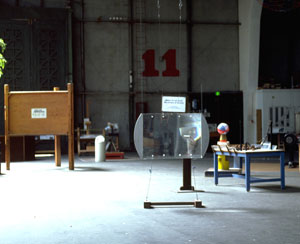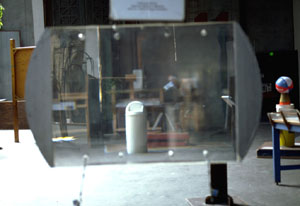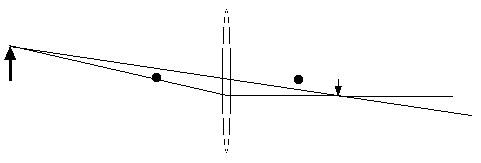
Notice the upside down real image of the distant white trashcan in the lens.
Image Real to Virtual
The eyes have it
Introduction
Look through a long focal length lens at a distant object and you can see either a real or a virtual image depending on your location.
Material
A long focal length lens such as a large Fresnel reading lens. (Sold as a page magnifier lens in the reading glasses section of many pharmacies, Rite-Aid in particular.)
Assembly
Mount the lens so you can look through it at a distant object. We clamp the bottom of the lens in large Binder clips.
The object should be several focal lengths from the lens.
To Do and Notice
Stand far from the lens and look though it.
Notice that the image of the distant object is upside down. It is a real image.

Notice the upside down real image of the distant white trashcan in
the lens.
Now walk up to the lens notice that the image goes blurry and then returns right-side-up, you are seeing a virtual image.

Near the lens you see a virtual image of the trashcan in the
lens.
What's Going On?
If you use ray tracing to find where the image is in this situation, or use an equation to calculate the location of the image, you will find that the image is a real image. So how is it that you can see a virtual image?

An object shown as a dark arrow on the left reflects light which passes through a lens . The lens bends the light and creates an inverted image of the arrow.
Using ray tracing or solving the equation missed out on one important lens in this system, the lens in the human eye.

When the eye is far from the lens, it creates an image on the retina
from the diverging light coming from the real image made by the
lens.

When the eye is near the lens, inside the focal point, it makes a
real image on the retina from the light that has passed through the
lens and is converging toward the real image. The real image would be
created behind the eye, the lens creates an image on the
retina.
The eye never encounters light converging from one point on an object when looking directly at objects in air, however it creates an image anyway the first time it views a scene through a lens, even though it is completely without experience.
The eye can change its focal length to allow it to create in-focus images of objects at different distances.
So What
The physics equations give no hint that when you actually look through a lens you might see an uninverted image when the lens is actually making an inverted real image behind your eye.
|
Scientific Explorations with Paul Doherty |
|
2 Sep 2005 |